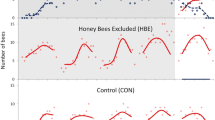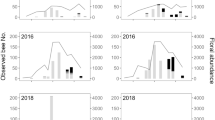Summary
Dynamical aspects of flower usage and forager body size in sympatric and experimentally-induced allopatric populations of Bombus flaviforns and Bombus rufocinctus were studied in 10 discrete subalpine meadows and over the last half of one summer. Results indicate that there is a high degree of asymmetry in the competitive effects and that B. flavifrons is the clear competitive and numerical dominant. When occurring alone, B. rufocinctus used the same spectrum of flowers in similar frequencies to that of B. flavifrons whose flower use was invariant over all meadows and treatments. When sympatric with B. flavifrons, B. rufocinctus was relegated to secondary, less preferred flowers. Shifts in flower use by B. rufocinctus were accompanied by changes in forager body-size: body weights were greater in allopatric populations of B. rufocinctus and smaller in those sympatric with B. flavifrons. Competitive dominance may be related to differences in species phenologies. Bombus flavifrons initiated colonies in the spring three weeks before B. rufocinctus and maintained higher densities over the summer; by virtue of greater numbers of foragers, it may control exploitation of the most profitable flowers.
Similar content being viewed by others
References
Abramsky Z, Bowers MA, Rosenzweig ML (1985) Detecting interspecific competition in the field: testing the model of Hallett and Pimm. Oikos (In press)
Anasiewicz A (1971) Observations on the bumble bees in Lublin. Ekol Pol 19:401–417
Bender EA, Case TJ, Gilpin ME (1984) Perturbation experiments in community ecology. Ecology 65:1–13
Bowers MA (1984) Population biology of bumble bees (Bombus) in subalpine meadows in northeastern Utah. PhD Dissertation, University of Arizona, Tucson
Bowers MA (1985) Bumble bee colonization, extinction and reproduction in subalpine meadows n northeastern Utah. Ecology 66:914–927
Brian AD (1951) Brood development in Bombus agrorum (Hym. Bombidae) Entomological Mon Mag 87:207–212
Brian AD (1954) The foraging of bumble bees I. Foraging behavior. Bee World 35:61–67
Brian AD (1957) Differences in the flowers visited by four species of bumble bees and their causes. J Anim Ecol 26:71–98
Cody ML, Diamond JM (1975) Ecology and Evolution of Communities. The Belknap Press of Harvard University Press, Cambridge, Massachusetts
Connell JH (1983) On the prevalence and relative importance of interspecific competition: evidence from field experiments. Am Natur 122:661–696
Cumber RA (1953) Some aspects of the biology and ecology of bumble bees bearing upon the yields of red clover seed in New Zealand. New Zealand J Sci Tech Bull 34:227–240
Free JB, Butler CG (1959) Bumble bees. Collins, London
Hasselrot TB (1960) Studies on Swedish bumble bees. Opuscula Entomol Suppl 17:1–203
Heinrich B (1976a) Resource partitioning among some eusocial insects: bumble bees. Ecology 57:874–889
Heinrich B (1976b) Foraging specialization of individual bumble bees. Ecol Mono 46:105–128
Heinrich B (1979a) “Majoring” and “minoring” by foraging bumble bees, Bombus vagans: an experimental analysis. Ecology 60:245–255
Heinrich B (1979b) Bumble bee economics. Harvard University Press, Cambridge, Massachusetts
Inouye D (1978) Resource partitioning in bumble bees: experimental studies of foraging behavior. Ecology 59:672–678
Inouye D (1980) The effect of proboscis and corolla tube lengths on pattern and rates of flower visitation of bumble bees. Oecologia 45:197–201
Lundberg H, Ranta E (1980) Habitat and food utilization in a subarctic bumble bee community. Oikos 35:303–310
Morse DH (1977) Resource partitioning in bumble bees: the role of behavioral factors. Science 197:678–679
Pleasants JM (1981) Bumble bee responses to variation in nectar availability. Ecology 62:1648–1661
Pyke GH (1979) Optimal foraging in bumble bees: rule of movement between flowers within inflorescences. Anim Behav 27:1167–1181
Pyke GH (1982) Local geographic distributions of bumble bees near Crested Butte, Colorado: competition and community structure. Ecology 63:555–573
Ranta E, Lundberg H (1980) Resource partitioning in bumble bees: the significance of differences in proboscis length. Oikos 35:298–302
Ranta E, Vepsäläinen K (1981) Why are there so many species? Spatiotemporal heterogeneity and northern bumble bee communities. Oikos 36:28–34
Ranta E, Lundberg H, Teras I (1981) Patterns of resource utilization in two Fennoscandian bumble bee communities. Oikos 36:1–11
Siegel S (1956) Nonparametric statistics for the behavioral sciences. McGraw Hill, New York, New York
Strong DR (1983) Natural variability and the manifold mechanisms of ecological communities. Am Natur 122:636–660
Svensson BG, Lundberg H (1977) Distribution of bumble bee nests in subalpine/alpine areas in relation to altitude and habitat (Hymenoptera, Apidae) Zoon 5:63–72
Waddington KD, Heinrich B (1981) Patterns of movement and floral choice by foraging bees. In: Kamil AC, Sargent TD (eds) Foraging Behavior: Ecological, Ethological, and Physiological approaches. Garland STPM Press, New York, New York
Whitham TG (1977) Coevolution of foraging in Bombus and nectar dispersing in Chilopsis: a last dreg theory. Science 197:593–595
Author information
Authors and Affiliations
Rights and permissions
About this article
Cite this article
Bowers, M.A. Experimental analyses of competition between two species of bumble bees (Hymenoptera: apidae). Oecologia 67, 224–230 (1985). https://doi.org/10.1007/BF00384289
Received:
Issue Date:
DOI: https://doi.org/10.1007/BF00384289




